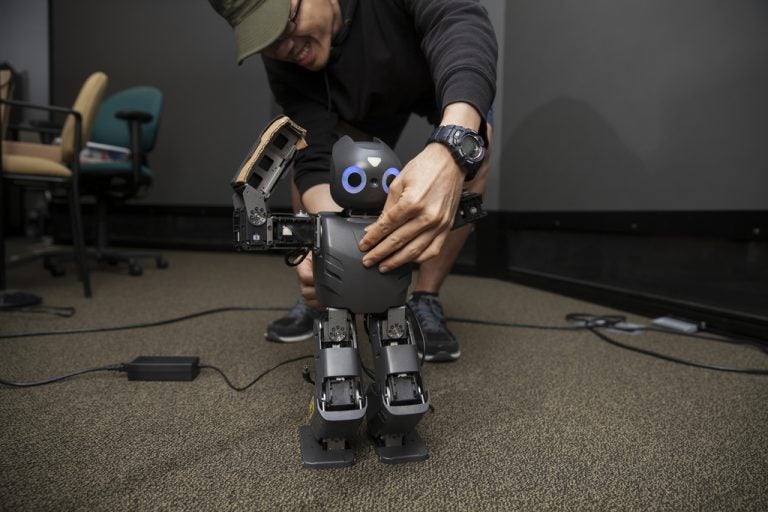From a three-in-one ocean rescue trailer, to a detection-and-alert system for parents who travel with infants in their car backseats, to a drone laser tag game, engineering students at the University of Central Florida will showcase some of their inventions and new technologies from 8 a.m. to 2 p.m. on Friday, April 24, during the Senior Design Showcase.
Some prototypes offer potential solutions to real-world problems. Others offer a bit more fun and have the potential for commercial development. It’s exactly what leaders in the College of Engineering and Computer Science want to see of their graduating seniors. The goal of the showcase is to give students a chance to display their final projects, demonstrate their technical knowledge and show they are fully prepared for engineering jobs. On a more practical level, the projects represent a significant portion of students’ grades and in many cases is the final step before graduation.
For a list of all the projects and the day’s line up of speakers click here.
The showcase includes some possibly life-saving inventions. For example, two teams developed different systems that would alert weary or forgetful parents that they’ve left their infant or toddler strapped into their car seat after the parent has walked away from the vehicle.
One team developed an app that sends the parent an alert message and buzz on a smart phone if they get beyond a certain distance from the vehicle. A sensor inside the vehicle, which detects life and temperature readings, triggers the phone alert. If the parent ignores or doesn’t hear the alert, the vehicle’s alarm and/or horn starts to blare, drawing attention to the vehicle.
“Though it sounds cliché, the feeling of knowing that this project could save lives creates an emotional attachment and accomplishment that is not easily described with words,” said team leader Eli Lorenzo, who will graduate May 7.
Another team took a different approach to reach the same goal. – saving children or pets left behind in hot locked vehicles.
Phillip Quintero’s team developed a system that has the ability to scan an area as big as a standard sedan’s backseat in order to detect if both life and a harmful environment exist. If both conditions are confirmed, a custom alarm will be signaled that can be heard up to 500 feet.
Among the markers the system scans for are temperature, humidity, carbon monoxide and carbon dioxide. The life-detection system uses ultrasonic sensors for motion, and infrared sensors for body temperature, Quintero said. If a toxic environment is detected, a custom alarm will sound. The two team members who graduate this summer hope to potentially add two features later– either automatically having vehicle windows come down once the alarm is activated or activating the air conditioning. The other two team members who graduate next month already have jobs lined up.
And then there’s the team lead by Brevard County’s Ocean Rescue Chief Jeff Scabarozi. He is responsible for overseeing lifeguard operations from Cape Canaveral to Melbourne Beach. When he decided to go back to school to get a second degree in mechanical engineering, he knew exactly what his project would be – a way to cut the time between rescuing a drowning swimmer and getting him or her to medical care on shore.
Scabarozi and his team developed a three-in-one trailer that can carry a personal watercraft on roads and also on sand. The trailer then can be used as a gurney to transport a patient over sand to an ambulance.
“I’ve had this idea for a while,” Scabarozi said. “It’s something we desperately needed. When I had the opportunity to pursue my engineering degree it was a perfect fit. And I had a lot of support from Bevard County to do it. ”
The trailer is already used on Brevard’s beaches, Scabarozi said. It was brought to UCF to show others how it works.
Brevard Ocean Rescue lifeguard Derek Swor will be on hand to explain the project because Scabarozi is making a presentation about the new trailer at the U.S. Lifesaving Association National Conference this week.
Not all the inventions attempt to solve life-and-death problems. One team came up with a game called Drone Hunt. The team adapted a drone to respond to laser tag shots while flying within a limited air space. Players use laser tag weapons to fire at the drone for a specific amount of time. When the time expires, the drone returns to its takeoff position. The computer aboard the drone logs data about the activity, including the accuracy of shots.
“We thought it would be fun for potential consumers,” said Emmanuel Martinez, who led the team of graduating seniors. “We also recognize that with some refinement there could potentially be some military-training applications here.”
The free showcase is open to the pubic and also includes a talk by alumna Grace Bochenek, director of the National Energy Technology Laboratory. Projects will be displayed inside and outside of the Engineering II building and the Harris Engineering Center on the main campus.
